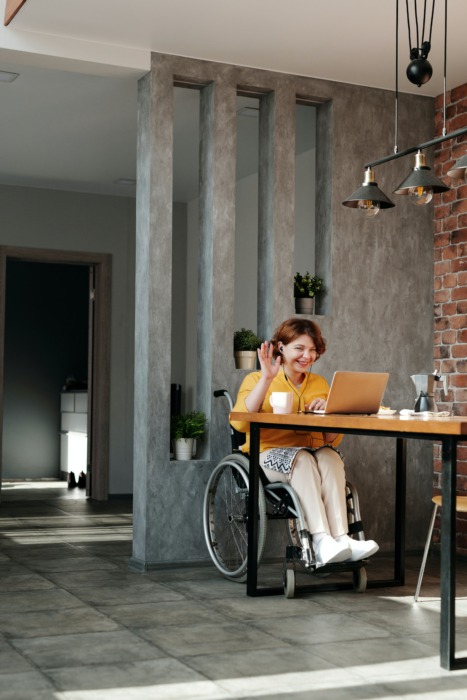
In the wake of COVID, remote support has become an even more vital service for people with disabilities. However, it’s somewhat misunderstood and often mistaken for assistive technology.
The INDATA Project at Easterseals Crossroads will help people better understand this service with its upcoming online training session, Remote Supports for Independent Living, on August 19.
Dustin Wright, the founder and CEO of Disability Cocoon, will lead most of the webinar.
Tech Support with a Human Element
Although they both incorporate enabling technology, remote support has a more interactive, human element.
“Assistive technology is technology that a person with a disability uses on their own to improve a functional capability, whether it’s a hearing aid, a screen reader or a smart home setup,” Wright said. “Remote support is a human being supporting another human being, live and in real time. It’s closer to a residential type of support or a direct care service, but it’s facilitated by technology.”

Remote support caregivers assist clientele through wireless sensors, two-way audio-video communication, and sometimes cameras in common areas of the home. Through this technology, a support vendor staff person can care for people with disabilities in several different ways.
“The services that each person gets are individualized and customized to fit their needs, abilities and preferences,” Wright said. “They provide general oversight in terms of watching out for potential falls, giving medication reminders, helping people make healthy meal choices, ensuring that visitors of the home are trustworthy and not strangers trying to take advantage of the person with a disability. They essentially provide the same services that a home caregiver would.”
If the client has a smart home setup, the remote caregiver can hook up to it and help control lighting, temperature, etc.
The History of Remote Support
Although remote support has been growing over the past 20 years, it’s still in the early adopters phase and considered new to many people within the industry.

Early development of remote support in the US dates back to a University of Wisconsin study in 2002 that tested whether an array of sensors within someone’s home could push alerts to a person monitoring it from a distant location. Conducted in the university’s Waisman Center, the study led to the founding of Night Owl Support Systems, which now serves people across the country through remote support.
More remote support companies entered the marketplace in the mid-2000s.
“In these early development days, there wasn’t any funding or regulatory environment in the US for this service,” Wright said. “So, there was a lot of work in creating the standards by which remote support would be provided through a waiver system. This was a brand new concept, and people thought we were crazy back then. ‘You’re going to put cameras and sensors in someone’s home?’ they asked in disbelief.”
The tipping point for the embrace of remote support arrived in 2016, when research from Ohio State University revealed the high efficacy of the service for people with disabilities. During the webinar, Jordan Wagner, coordinator of the university’s Nisonger Center Technology Project, will lead attendees in a deep dive of this research.
Indiana was the first state to fund remote support. By 2016, a dozen states followed suit. Pre-COVID, roughly 20 states were funding the service. The number of support vendors increased rapidly in that timeframe as well.
“If there was a silver lining with COVID, it’s that it forced our industry and the people we serve to look at this technology as an option for managing everyday life when we really had no other viable option,” Wright said.
The Future of Remote Support

As the remote support industry continues to grow in the wake of COVID, Wright wants people to leave the webinar thinking about the wide world of possibilities this service offers.
“The goal of our industry is to maximize people’s independence while ensuring health and safety. But remote support helps us, the providers, as well,” Wright said. “It will alleviate the chronic workforce shortage that’s been plaguing our industry for decades by providing remote caregiver jobs. It will also be valuable for taxpayers and the Medicaid system by driving down the overall cost of care and providing a more efficient form of support. This is a win-win-win scenario. It’s a win for the people served. It’s a win for the agencies supporting those people. And it’s a win for the system as a whole.”
If you miss the upcoming webinar on remote support, you can view it in INDATA’s archive of full-day training sessions.
